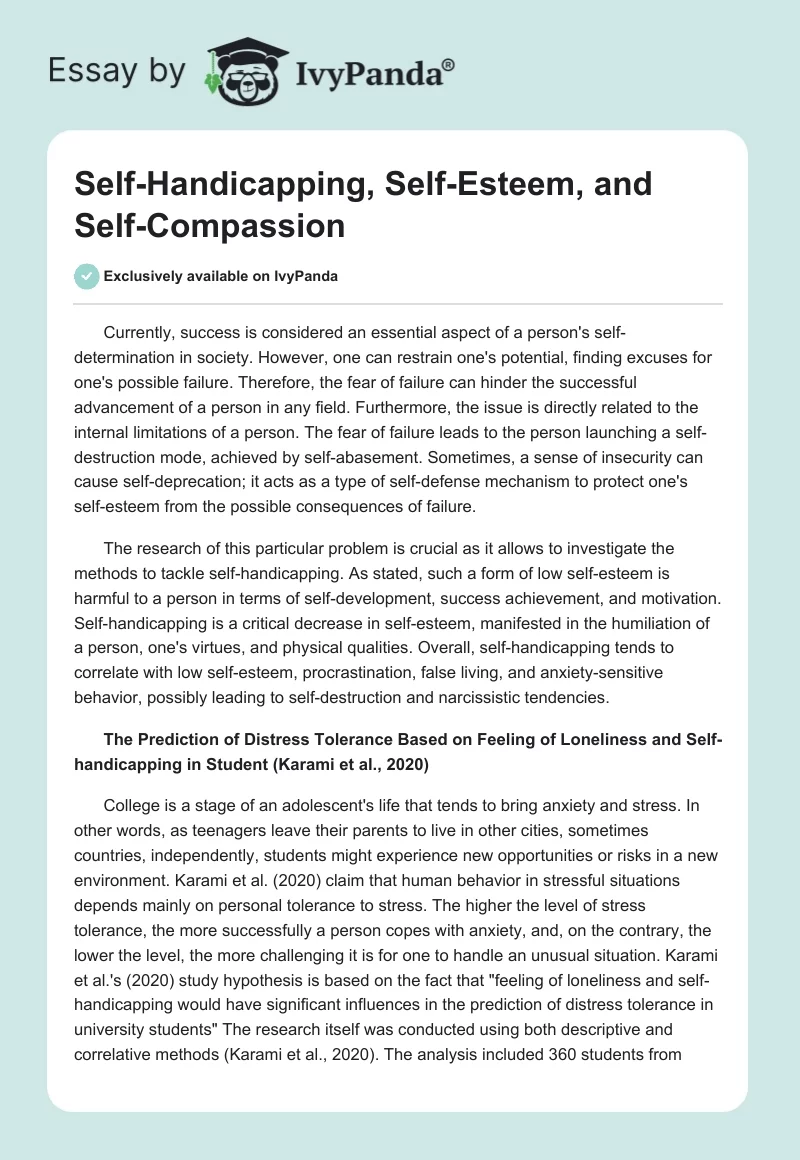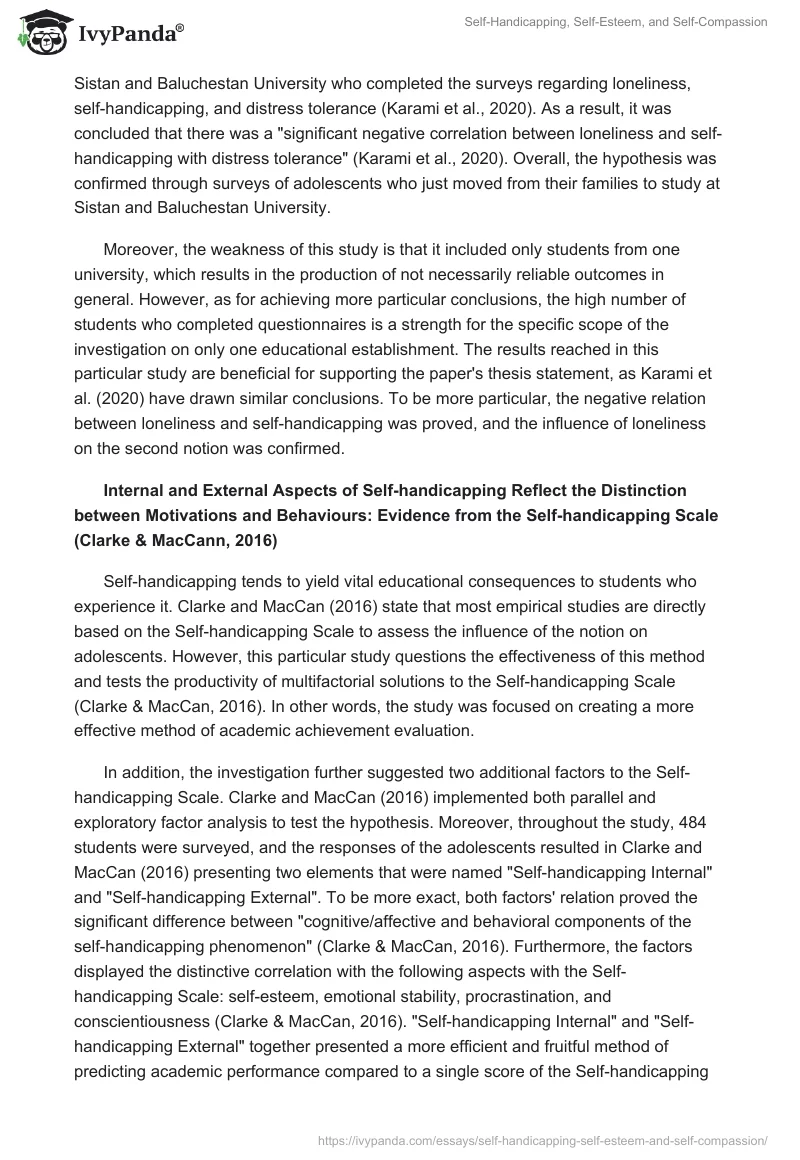Currently, success is considered an essential aspect of a person’s self-determination in society. However, one can restrain one’s potential, finding excuses for one’s possible failure. Therefore, the fear of failure can hinder the successful advancement of a person in any field. Furthermore, the issue is directly related to the internal limitations of a person. The fear of failure leads to the person launching a self-destruction mode, achieved by self-abasement. Sometimes, a sense of insecurity can cause self-deprecation; it acts as a type of self-defense mechanism to protect one’s self-esteem from the possible consequences of failure.
The research of this particular problem is crucial as it allows to investigate the methods to tackle self-handicapping. As stated, such a form of low self-esteem is harmful to a person in terms of self-development, success achievement, and motivation. Self-handicapping is a critical decrease in self-esteem, manifested in the humiliation of a person, one’s virtues, and physical qualities. Overall, self-handicapping tends to correlate with low self-esteem, procrastination, false living, and anxiety-sensitive behavior, possibly leading to self-destruction and narcissistic tendencies.
The Prediction of Distress Tolerance Based on Feeling of Loneliness and Self-handicapping in Student (Karami et al., 2020)
College is a stage of an adolescent’s life that tends to bring anxiety and stress. In other words, as teenagers leave their parents to live in other cities, sometimes countries, independently, students might experience new opportunities or risks in a new environment. Karami et al. (2020) claim that human behavior in stressful situations depends mainly on personal tolerance to stress. The higher the level of stress tolerance, the more successfully a person copes with anxiety, and, on the contrary, the lower the level, the more challenging it is for one to handle an unusual situation. Karami et al.’s (2020) study hypothesis is based on the fact that “feeling of loneliness and self-handicapping would have significant influences in the prediction of distress tolerance in university students” The research itself was conducted using both descriptive and correlative methods (Karami et al., 2020). The analysis included 360 students from Sistan and Baluchestan University who completed the surveys regarding loneliness, self-handicapping, and distress tolerance (Karami et al., 2020). As a result, it was concluded that there was a “significant negative correlation between loneliness and self-handicapping with distress tolerance” (Karami et al., 2020). Overall, the hypothesis was confirmed through surveys of adolescents who just moved from their families to study at Sistan and Baluchestan University.
Moreover, the weakness of this study is that it included only students from one university, which results in the production of not necessarily reliable outcomes in general. However, as for achieving more particular conclusions, the high number of students who completed questionnaires is a strength for the specific scope of the investigation on only one educational establishment. The results reached in this particular study are beneficial for supporting the paper’s thesis statement, as Karami et al. (2020) have drawn similar conclusions. To be more particular, the negative relation between loneliness and self-handicapping was proved, and the influence of loneliness on the second notion was confirmed.
Internal and External Aspects of Self-handicapping Reflect the Distinction between Motivations and Behaviours: Evidence from the Self-handicapping Scale (Clarke & MacCann, 2016)
Self-handicapping tends to yield vital educational consequences to students who experience it. Clarke and MacCan (2016) state that most empirical studies are directly based on the Self-handicapping Scale to assess the influence of the notion on adolescents. However, this particular study questions the effectiveness of this method and tests the productivity of multifactorial solutions to the Self-handicapping Scale (Clarke & MacCan, 2016). In other words, the study was focused on creating a more effective method of academic achievement evaluation.
In addition, the investigation further suggested two additional factors to the Self-handicapping Scale. Clarke and MacCan (2016) implemented both parallel and exploratory factor analysis to test the hypothesis. Moreover, throughout the study, 484 students were surveyed, and the responses of the adolescents resulted in Clarke and MacCan (2016) presenting two elements that were named “Self-handicapping Internal” and “Self-handicapping External”. To be more exact, both factors’ relation proved the significant difference between “cognitive/affective and behavioral components of the self-handicapping phenomenon” (Clarke & MacCan, 2016). Furthermore, the factors displayed the distinctive correlation with the following aspects with the Self-handicapping Scale: self-esteem, emotional stability, procrastination, and conscientiousness (Clarke & MacCan, 2016). “Self-handicapping Internal” and “Self-handicapping External” together presented a more efficient and fruitful method of predicting academic performance compared to a single score of the Self-handicapping Scale alone (Clarke & MacCan, 2016). Overall, the results of the surveys suggested the separation of measures from the Self-handicapping Scale into multiple components.
The critical weakness of the research is that the reached outcomes must be further researched to prove their reliability in general implementation, considering that such a method had never been presented before. However, Clarke and MacCan still enforced a strong and throughout analysis that enabled the possibility to draw satisfactory conclusions from the investigation. Overall, the study presented the need to evaluate the relation between self-handicapping and the aspects that are proved to provoke it through multiple scales. Furthermore, it still proved the existence of a correlation between the development of self-handicapping through self-esteem, procrastination, and emotional stability, as stated in the paper’s thesis statement.
Perception of Self-handicapping Behavior in the Workplace: Not that Great (Shin & Park, 2018)
Sometimes the evaluation of self-handicapping behavior may differ with current people’s environments. For instance, the examinations of self-handicapping in terms of impression management strategy have reached disparate outcomes between employees and students (Shin & Park, 2018). The primary purpose of this particular study was to achieve the generalization of results among workers (Shin & Park, 2018). Throughout the analysis, Shin and Park (2018) aimed to replicate the previous study of Park and Brown and managed to extend it to workers in South Korea. The study included the surveys of 252 workers that were to choose the aspect that had a more significant influence on their behavior between the following “self-handicapping vs control” and “success vs failure” (Shin & Park, 2018). Furthermore, the participants evaluated each aspect to acknowledge “ability, effort, external factors, and luck” and their eagerness to collude with these components (Shin & Park, 2018). Overall, the employees were more inclined to positively evaluate control and success aspects (Shin & Park, 2018). Another critical point is that the conclusions were drawn through assessing the self-handicapping and control targets separately.
The study’s principal strength is its dependence on already researched notions, which leads to more reliable conclusions. However, Shin & Park still faced inconsistencies in their research when the participants’ answers did not correspond to their condition. To be more exact, 33 workers were excluded from the examination due to the failure of the study’s model (Shin & Park, 2018). Overall, this study is strongly related to the correlation of self-handicapping with defeat in the working environment. Once again, the thesis statement is supported by the outcomes that prove notions’ direct dependence on each other.
Achievement Goals, Fear of Failure and Self-Handicapping in Young Elite Athletes with and without Chronic Pain (Molenaar et al., 2021)
It is fair to claim that elite athletes are exposed to pain in their daily training and practice. Thus, the goal orientation in the sports sector is directly dependant on fear of failure, self-handicapping, and pain complaints among young sportspeople (Molenaar et al., 2021). This study mainly focuses on examining the association between self-handicapping and pain, goal orientations, and fear of failure (Molenaar et al., 2021). Molenaar et al. (2021) analyzed the influence of self-handicapping on sports achievement and performance among young people. Overall, the investigation included the following type of analysis: correlation and multivariate regression (Molenaar et al., 2021). Throughout the study, 126 young athletes’ data were examined, focusing on the influence of chronic pain on the development of both self-handicapping and fear of failure (Molenaar et al., 2021). The research concluded that 47% of participants who endured pain regularly were more likely to experience self-handicapping and conditions strongly related to the notion (Molenaar et al., 2021). In other words, self-handicapping is directly dependant on the intensity of pain among young athletes.
The outcomes of this study might be considered unreliable since athletes’ pain was evaluated only through questionnaires and surveys. However, it seems apparent that young people did not necessarily provide accurate information regarding their overall conditions. Still, this research serves as a solid basis to further in-depth analysis in this field to investigate the relation between pain suffering and self-handicapping development. Overall, the study presents the direct influence of the self-handicapping notion on fear of failure and goal orientation. The outcomes of the research support the main idea displayed in this academic paper considerably.
Self-Handicapping Among University Students: The Role of Procrastination, Test Anxiety, Self-Esteem, and Self-Compassion (Barutçu Yıldırım & Demir, 2019)
Self-handicapping is frequently used among students as an excuse for poor performance in evaluative situations. In other words, young people opt for claiming obstacles in the way of achieving fruitful academic results to protect their self-competence. Thus, this study’s primary purpose was to investigate the correlation between self-handicapping and procrastination, anxiety, self-comparison, and self-esteem (Barutçu Yıldırım & Demir, 2019). Throughout the research, Barutçu Yıldırım and Demir (2019) employed the following methods of evaluating mentioned factors: “the Self-Handicapping Scale, Tuckman Procrastination Scale, Anxiety Subscale of Academic Emotions Questionnaire, Rosenberg Self-Esteem Scale, and Self-Compassion Scale”. Consequently, data was collected through the stated practices from 801 undergraduate students, 404 women, and 397 men (Barutçu Yıldırım & Demir, 2019). 59% of university students showed satisfactory results to support the principal hypothesis of this particular study (Barutçu Yıldırım & Demir, 2019). Nevertheless, the semi-partial analysis of self-handicapping dependence on self-esteem, test anxiety, self-comparison, and procrastination concluded the following correlation results: 2%, 4%, 2%, and 17%, respectively (Barutçu Yıldırım & Demir, 2019). Overall, the examination of statistics presented that procrastination, anxiety, self-comparison, and self-esteem directly impact the development of self-handicapping.
The properly conducted study produced reliable conclusions since it had a strong basis from previous research. Barutçu Yıldırım and Demir (2019) employed various methods for evaluating the correlation between self-handicapping and self-esteem, test anxiety, self-comparison, and procrastination. Thus, the two-factor analysis also contributed to yielding reliable outcomes that can be used for further investigations on the topic. Overall, the study proves the direct influence of self-esteem, anxiety, and procrastination on self-handicapping, strongly supporting the thesis statement of this paper.
References
Barutçu Yıldırım, F., & Demir, A. (2019). Self-Handicapping Among University Students: The Role of Procrastination, Test Anxiety, Self-Esteem, and Self-Compassion. Psychological Reports, 123(3), 825–843. doi:10.1177/0033294118825099
Clarke, I. E., & MacCann, C. (2016). Internal and external aspects of self-handicapping reflect the distinction between motivations and behaviours: Evidence from the Self-handicapping Scale. Personality and Individual Differences, 100, 6–11. doi:10.1016/j.paid.2016.03.080
Karami, A., Khodarahimi, S., Ghazanfari, F., Mirdrikvand, F., & Barigh, M. (2020). The prediction of distress tolerance based on the feeling of loneliness and self-handicapping in students. Personality and Individual Differences, 161. doi:10.1016/j.paid.2020.109994
Molenaar, B., Willems, C., Verbunt, J., & Goossens, M. (2021). Achievement Goals, Fear of Failure and Self-Handicapping in Young Elite Athletes with and without Chronic Pain. Children, 8(7), 591. doi:10.3390/children8070591
Shin, H., & Park, S. W. (2018). Perception of self-handicapping behavior in the workplace: Not that great. Current Psychology, 40(2), 910–918. doi:10.1007/s12144-018-0013-6


